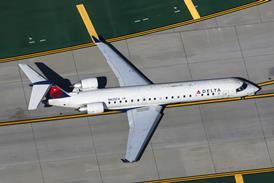AARON KARP / WASHINGTON DC & DAVID LEARMOUNT / LONDON
Contention surrounds a proposed redesign of an MD-83 component following the Alaska Airlines crash in January 2000
A split has developed inside the US National Transportation Safety Board (NTSB) over whether a component with exceptional reliability needs to be failsafe.
A crucial pitch-control mechanism flying in more than 1,800 civil aircraft is not failsafe and should be redesigned, according to some senior NTSB officials conducting a final scrutiny of the draft report on the 31 January 2000 Alaska Airlines Boeing MD-83 crash. Opinion within the NTSB is split, however, on whether a redesign is necessary, and the recommendation from the final hearing is that, "if practical", Boeing should incorporate a failsafe device in the type's horizontal stabiliser pitch control assembly.
The MD-83 component that failed is the screw-jack assembly controlling the horizontal stabiliser pitch angle. The autopilot uses the stabiliser to control pitch and pilots use it to trim the aircraft when flying manually. The screw-jack mechanism is the sole component that sets and limits stabiliser pitch, and NTSB director of aviation safety John Clark says: "If this component fails, it leads to catastrophic failure." The same basic mechanism is used in all McDonnell DouglasDC-9s, Boeing MD-80s and MD-90s, and the DC-9-based 717.
In the accident aircraft, says the NTSB, inadequate lubrication of the screw-jack had worn down and finally stripped the thread from the gimbal nut that travels up or down the screw-jack to alter stabiliser pitch. Aerodynamic forces then jammed the stabiliser fully leading-edge-up, pitching the aircraft nose-down so strongly that elevator forces could not counteract it. Boeing says if the assembly jams at any point in the normal travel range the aircraft remains controllable, but in the accident it moved outside the normal limits. A factor in the lubrication failure was that the channels in the nut into which lubricating grease is pumped manually at eight-monthly intervals had become blocked by dried grease, says Boeing.
Other NTSB staff argue the component is reliable. Boeing notes that this accident is the only time the assembly's gimbal nut thread has stripped - or that the basic assembly has failed - causing a serious accident in "more than 100 million flying hours" since the DC-9 was introduced in 1965. "I'm pretty confident we've nailed [the cause] as a lubrication issue," explains NTSB systems group chairman Jeff Guzzetti. Clark, however, argues for a redesign: "If maintenance were perfect there would never be a problem. It's the unknown that's worrisome...if something is going to go wrong, can we mitigate it or prevent it happening?"
Early in the investigation, after a maintenance audit, the Federal Aviation Administration fined the carrier $1 million as a result of the highly unsatisfactory findings. The NTSB has also castigated the FAA's maintenance oversight.
Source: Flight International























